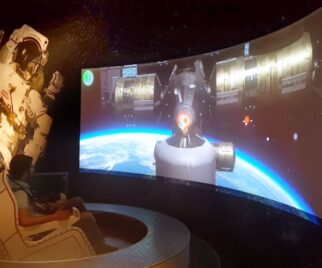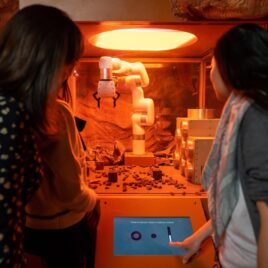In the vast expanse of science centers, space museums, and other themed environments Interactive Air and Space Exhibits serve as cosmic gateways, transporting visitors to the far reaches of the universe. These exhibits not only inspire awe but also provide a dynamic platform for hands-on exploration of the wonders of the skies and beyond. Let’s embark on a cosmic journey through the immersive experiences offered by these interactive exhibits.
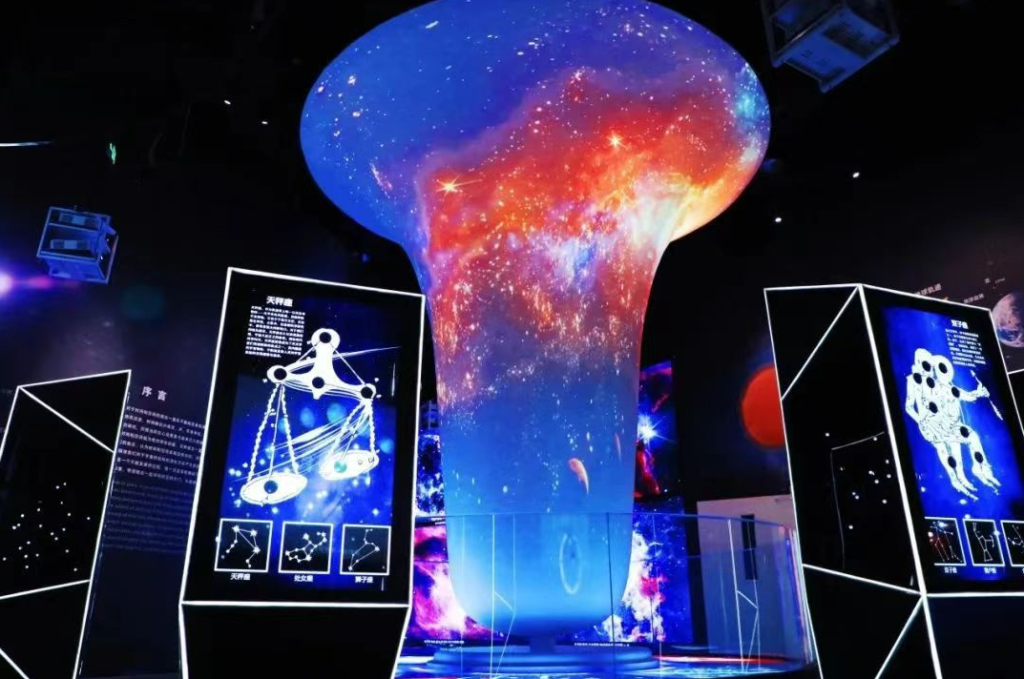
A List of Interactive Air and Space Exhibits
- Air Fog Cannon
- Vortex Cannon
- Amazing Airways
- Digital Telescope
- Gravity Well (Black Hole)
- How Big is the Universe?
- From Quarks to the Cosmos
- Paper Plane Launcher
- Air Rocket
- Rocket Launcher
- Wind Tubes
- Space Age
- Solar System Scale
- Titans of Space (VR Space)
- Constellations Wall
- Stars
- Jetpack Simulator
- Astronaut Training Simulator
- Centrifuge (Astronaut Training Centrifuge)
- Gyroscope
- Human Gyroscope
- Orbitron
- Design Your Spaceship
- Explorer Robot (Mars Robot)
- Earth Orbit
- Flight of Birds
- Flight Simulator
- Walk on the Moon (Moonwalk)
- Orrery (Mechanical Solar System)
- Planet Models
- Solar System Planets
- Rocket Models
- Space Bike (G Force Bike)
- Space Exploration Wall
- Space Quiz
- Space Shuttle Simulator
- Space Station (International Space Station Model)
- VR Flight (Virtual Reality Flight)
- Spinning Chair
- Wind Tunnel (Aerodynamics)
- Infrared Camera (Thermal Imaging Camera)
- Northern Lights (Aurora Borealis)
- Gravity Trap
- Huygens Pendulum Clock
- Galileo’s Pendulum
- Photon Motion
- The Doppler Effect: Red Shift and Blue Shift
- The Sun, Earth and Moon
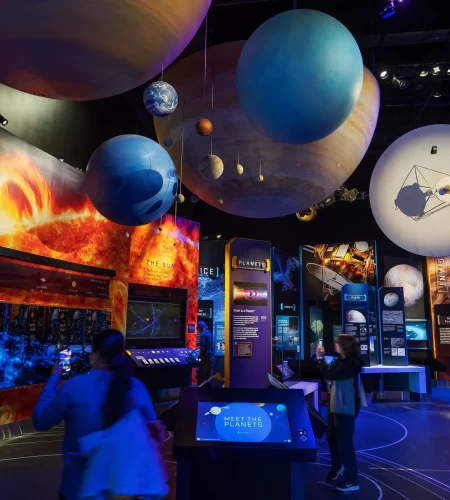
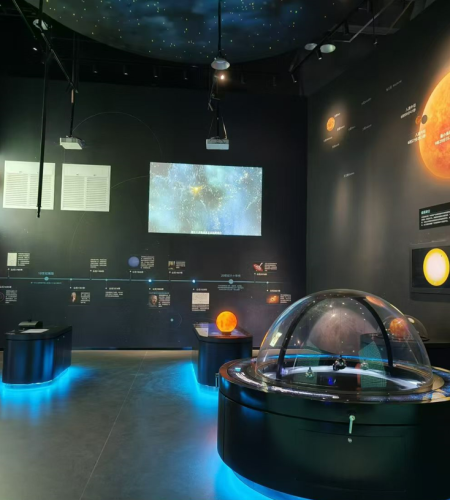
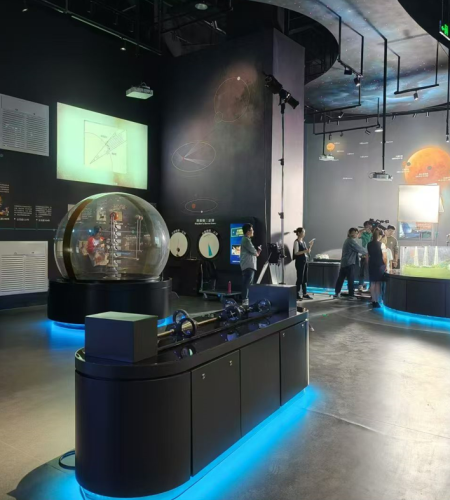
Significance of Interactive Air and Space Exhibits
Bringing Complex Concepts Down to Earth
Air and space topics can often feel abstract or challenging, especially for younger audiences. Interactive exhibits help demystify these ideas by translating them into tangible experiences, allowing visitors to see, feel, and explore principles of aerodynamics, gravity, planetary motion, and propulsion. Whether it’s through launching air rockets, simulating a moonwalk, or experimenting with a vortex cannon, these exhibits make scientific principles accessible, grounding them in memorable activities that help visitors understand and retain complex concepts.
Encouraging Curiosity and Lifelong Learning
Air and space exhibits inspire curiosity and exploration, encouraging visitors of all ages to ask questions and seek out new knowledge. Simulators like jetpacks, astronaut training devices, and virtual reality tours of Mars colonies and the International Space Station immerse visitors in the worlds of astronauts and scientists, igniting a desire to learn more about these fields. This curiosity is especially valuable for young visitors, who may become motivated to pursue careers in science, technology, engineering, and mathematics (STEM) after an inspiring museum experience.
Promoting STEM Education and Skills Development
The hands-on nature of interactive air and space exhibits offers an effective means of promoting STEM education. From designing model rockets to engaging in planetary weight comparisons, these activities build problem-solving, critical thinking, and teamwork skills. Exhibits like wind tunnels and flight simulators give practical insights into engineering and physics concepts, which are essential in the fields of aerospace and mechanical engineering. By providing young minds with these hands-on educational experiences, science centers and museums contribute significantly to the future STEM workforce.
Cultivating Environmental Awareness
Through interactive air and space exhibits, visitors gain a better understanding of Earth’s atmosphere and climate and the effects of pollution, space exploration, and more. Exhibits such as the AR Sandbox, which simulates topographic changes on Earth, and digital globes that showcase environmental data can inspire reflection on the delicate balance of our ecosystem. By highlighting environmental topics, these exhibits remind visitors that our journey into space is directly tied to our stewardship of Earth.
Sparking Inspiration and Creativity
By opening doors to the cosmos and revealing the science behind flight and planetary exploration, interactive air and space exhibits inspire and engage. They allow visitors to experience what it might be like to step onto another world or to glimpse faraway galaxies. These experiences bring people closer to understanding the universe and our place within it, making every visitor a part of humanity’s journey to explore the stars.
Interactive air and space exhibits are more than just educational tools—they are portals to inspiration, discovery, and a greater appreciation of the universe and our planet.
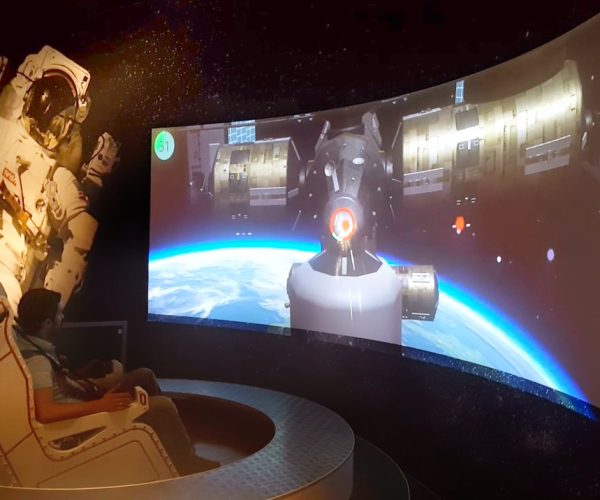
Empowering Change Through Interactive Learning
These Interactive Air and Space Exhibits transform science centers, space museums and other themed venues into celestial playgrounds, where visitors can engage with the cosmos in ways that are both educational and entertaining. From simulating cosmic phenomena to launching rockets, exploring constellations, experiencing weightlessness, and delving into planetary exploration, these exhibits make the wonders of the universe accessible to all. As visitors interact with these cosmic showcases, they not only gain a deeper understanding of space science but also ignite a sense of curiosity and wonder that extends beyond the boundaries of our planet. The cosmos comes alive through the immersive experiences provided by these exhibits, inviting everyone to embark on a journey of celestial discovery.


